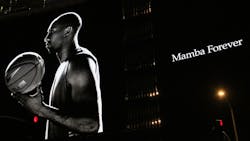Using Kobe Bryant’s mamba mentality in your dental hygiene career
Kobe Bryant said that the mamba mentality is the “simplest form of just trying to get better at whatever you’re doing.”1 In other words, try to be the best version of yourself. No matter what your occupation, everyone can benefit from Bryant’s mindset. While he’s considered one of the greatest basketball players, he realized the biggest impact he could make was off the court. Bryant knew that basketball was only one part of his life, and his true calling would be what came after. He realized that he could use his platform to make a difference. It’s the mentality he created on the court that serves as the foundation of his legacy.
Just as Bryant knew at a young age that his passion was basketball, I knew at age seven that I wanted to make people happy with their smiles. I have been a registered dental hygienist for nine years. Five years ago, I began my journey as a certified orofacial myologist and airway advocate.
As hygienists, we are constantly trying to find new ways to improve our patients’ quality of life. We take continuing education courses and stay updated on clinical research and best industry practices. I remember the first time I read about orofacial myofunctional therapy, and after doing my own research, I realized, “This is it! This is that extra I need in my hygiene career. Why not go that extra step?”
Just like Bryant made an impact beyond the basketball court, we have the opportunity to make an impact that extends much further than the dental hygiene operatory. I think we can all agree that making a difference in our patients’ lives is one of the most rewarding facets of our jobs. Why not get to the root of patients’ problems instead of merely treating symptoms with Band-Aids? You can do this daily, whether you choose to stay in your current role as a registered dental hygienist or expand your career to become an orofacial myologist. We are all in this together.
Mallampati score
A quick look at the back of the throat to see what structures are visible (Mallampati score)2 or a simple sleep screening questionnaire given to patients along with their medical history is all you need to spark a simple, possibly life-changing conversation. You can become an airway advocate and fill your dental sleep toolbox. Our patients need us. We may not have the entire solution, but we can certainly be a critical component to a successful, team-approach treatment plan.
Dental professionals are at the forefront of this endeavor. After all, airway trumps everything. We can live about three weeks without food and three to four days without water, but we can’t live without air for more than a few minutes without causing brain damage or death. In October 2017, the American Dental Association (ADA) released a policy statement addressing dentistry’s role in sleep-related breathing disorders.3 The policy encourages dental professionals to screen patients for obstructive sleep apnea (OSA), upper airway resistance syndrome (UARS), and other breathing disorders. It is important to not just focus on OSA, but rather the umbrella term—sleep-related breathing disorders or sleep-disordered breathing.
In anesthesia, the Mallampati score (or Mallampati classification) is used to predict the ease of intubation. It can also be used to predict whether a patient might have obstructive sleep apnea. The higher their score, the more likely someone has sleep apnea, although it is not 100% predictive.4 Have the patient sit upright in a neutral position. Next, instruct the patient to open their mouth and extend their tongue. Then, observe what structures can or cannot be seen: soft palate, uvula, fauces, and pillars.4 There are many resources and photos available for viewing online by searching for “Mallampati classification.”
The classifications are:
- Class 1—soft palate, fauces, uvula, anterior and posterior pillars visible
- Class 2—soft palate, fauces, uvula visible
- Class 3—soft palate, base of uvula visible
- Class 4—soft palate not visible
There are multiple sleep screenings and questionnaires available that include the Epworth Sleepiness Scale, Berlin questionnaire, Stop-Bang questionnaire, and the Pediatric Sleep questionnaire. The Mallampati score and sleep screening questionnaires are examples of assessments used in dental and medical practices. They are not the only assessment tools used.
As a certified orofacial myologist, I work collaboratively with general and pediatric dentists, orthodontists, oral and maxillofacial surgeons (OMFS), otolaryngologists (ENTs), speechlanguage pathologists, and other health-care professionals. I am excited to see what is in store for the field of orofacial myofunctional therapy and the positive impact it will continue to have on my career, on dental hygiene, and most importantly, on our patients’ lives. When you truly believe in the services you provide, the possibilities are endless!
Kobe Bryant will forever be remembered as an NBA legend, an Academy Award winner, and a role model for people of all ages. As dental hygienists we can use Bryant’s mamba mentality as we stand together to advocate for airway awareness and further expand the role of dental hygiene.
References
1. Brandt T. Mamba mentality: the mindset that made Kobe Bryant a master. Foundation for Economic Education. January 30, 2020. http://fee.org/articles/mamba-mentality-the-mindset-that-made-kobe-bryant-a-master/
2. Nuckton TJ, Glidden DV, Browner WS, Claman DM. Physical examination: Mallampati score as an independent predictor of obstructive sleep apnea. 2006;29(7):903-908. doi: 10.1093/sleep/29.7.903.
3. ADA adopts policy on dentistry’s role in treating obstructive sleep apnea, similar disorders. October 23, 2017. American Dental Association. https://www.ada.org/en/press-room/news-releases/2017-archives/october/ada-adopts-policy-on-dentistry-role-in-treating-obstructive-sleep-apnea
4. O’Brien SM. Understanding the Mallampati score. Clinical Advisor. February 4, 2016. http://www.clinicaladvisor.com/home/the-waiting-room/understanding-the-mallampati-score
BRITTNY SCIARRA, BS, RDH, COM, QOM, is a certified orofacial myologist and Buteyko practitioner. She is the owner of CT Orofacial Myology, an advocate for the Foundation of Airway Health, and a member of the American Academy of Physiological Medicine & Dentistry. Sciarra is also cofounder of Dental Sleep Toolbox, which educates and guides others in their path to becoming an airway-focused health-care provider. She hosts the podcast I Spy with My Myo Eye and can be found on Facebook or YouTube under CT Orofacial Myology. Contact her at [email protected] or visit ctorofacialmyology.com.
About the Author

Brittny Sciarra, BS, RDH, COM, QOM
B
RITTNY SCIARRA, BS, RDH, COM, QOM, is a certified orofacial myologist and Buteyko practitioner. She is the owner of CT Orofacial Myology, an advocate for the Foundation of Airway Health, and a member of the American Academy of Physiological Medicine & Dentistry. Sciarra is also cofounder of Dental Sleep Toolbox, which educates and guides others in their path to becoming an airway-focused health-care provider. She hosts the podcast I Spy with My Myo Eye and can be found on Facebook or YouTube under CT Orofacial Myology. Contact her at [email protected] or visit ctorofacialmyology.com.
